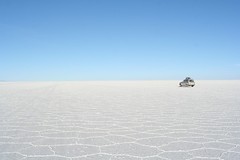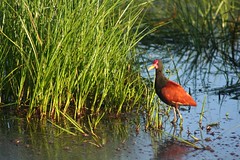A tree against the sky
Click on pic to see slideshow
or here to access the set
Day 1 - the start of the Inca Trail
We woke up at 4:30am because the tour agency bus was supposed to arrive at 5am to pick us up. We left our big bags in the hostel storage and gave the hostel night attendant our computer bag with the money belts to put in the safe. I counted the money in front of him, put one of our wire locks on the zipper and gave him the whole. Before we could have some breakfast, our contacts arrived and we headed on a freezing cold bus to pick up 14 other passengers and drove to kilometer 82 of the valley road, where the trek begins. We stopped in Ollantaytambo to have breakfast and as soon as we got off the bus we were attacked by local vendors - walking poles, hats, gloves etc. I negotiated with them but they were tough nuts and keep saying “for my family”. After breakfast we headed off for another hour or so down a dirt road to the beginning of our hike.
The first hiking day wasn’t too hard, it’s sort of a warm-up day and there are water and candy sellers all along the trail. The longer you walk, the higher the water prices get. Basic economics, I guess… Our sleeping bags worked well that night; REI didn’t lie to us about the quality of their products...
The group was a fair mix, with a slightly higher ratio of males, ages between 20 and 36. The young people (Angela kept calling them “The Runners”) - about 6 of them, were always ahead going fast, including one Canadian girl who just couldn’t stop talking, whether she was walking up the hill, sitting down for dinner or having just woken up. There were 4 Norwegians who mostly stuck to themselves, fast goers as well, and a few other couples from the US, nice people, and usually as slow as us.
Our guides - Max and Gladys – proved quite helpful from the beginning and our porters, about 20 of them loved to play card games at night and were always first to the scene with their 40lb packs, literally running by you on the trail, smiling all the time. Don’t even think to compete with these people…
Dead woman's pass - 4200m
Day 2 - Inca Trail Hell
On the mountain waking up is always before dark, usually around 5am. There’s nothing wrong with this since we’ve been sleeping since 8:30pm the previous day, but Angela started to come down with a bad cold which only got worse during this day and the next and ruined her trip.
Day 2 is the toughest day of the trip: the trail ascends up to about 4200 meters and then goes down for 5 or 6 hundreds. Going up wasn’t easy on Angela with her cold in the frozen morning air; as for myself, I discovered that I was sufficiently in shape for this endeavor, but I took it easy nonetheless, knowing that I haven’t taken a serious hike in a long time. Of course, “the runners” made it to the top way ahead of us and had to wait there for a while until everybody made it for the group picture…
Finally we had to descend for hours on the ancient Inca stone stairs and Angela’s walking pole came in very handy but her knees started to hurt. I know very well the sudden pain jolts caused by long downhill walks and I have felt like that in the past, but surprisingly and luckily, this time my knees were just fine all the way. Maybe the many hours of walking I’ve added up during this trip and the short hikes up and down so many ruins have helped.
We made it to the tents around 2:30pm and almost immediately went to sleep until dinner time. In total we hiked 9 hours. 3am rolled around and Angela ran out of the tent and didn’t come back until 45 minutes later, having taken over the bathroom with terrible diarrhea. It just kept getting better...
Day 3 - Inca Trail and sick people
By the time 4:30am came around Angela’s cold has gotten worse, but the diarrhea was under control. Some other people were sick with stomach issues while others were perfectly fine. It must have been the food or the water they used to cook and make tea and juice with. The water was supposed to be purified with iodine and boiled but you never know how long they were boiling it…
At breakfast (and every other meal), the cook gave Angela a special plate omitting eggs and dairy products. This usually creates a little embarrassment at the first meal, when everybody around the table has to find out about her stomach issues. But there’s no shortage of people interested in hearing about this and ready to share their own digestive problems with you.
Within 1½ hour after departure we were at the “top” (meaning the highest altitude we were going to climb that day) happy to be done with the hardest part of the trek (we thought). Even Angela made it uphill like an Energizer bunny, taking sips of coca tea every few steps.
The next part of the trail was relatively easy, going a little way up and down through the cloud forest, but the day ended with a thousand-step descent toward the night camp which was very hard on Angela’s already weaken knees; she limped but nevertheless we made it safely together. Her bronchitis however didn’t seem to show signs of relief.
Day 3 was when we were supposed to tip. The instruction sheet given by the company was complicated and useless and I had to stop people from trying to find exact bills and coins to divide the money into 20 equal parts for all the porters, as they initially thought it had to be done. I tip - I don’t want to have to divide the money to make sure all recipients are happy. As I correctly anticipated, the head porter gets the money and divides it, but it gets it from us in front of the whole gang, so everybody knows what the sum is. If anybody feels cheated, they can always kill the head porter, their business, not mine.
There wasn’t too much money gathered and I’m sure some people tipped at the low end, but that’s a personal decision so I wasn’t going to try to change people’s minds. I’m usually not a very generous spender and I tip a little above the middle, but this time I felt quite guilty for the small total sum and added more money to the pot than I would have liked to. Thank god Angela was sick in bed and didn’t get up to insult who she may have thought tipped badly…
Dawn at the lost city
Click on pic to see slideshow
or here to access the set
Day 4 - How it can always go worse than you thought
Because every group wants to be the first at the checkpoint and of course, at the ruins, we woke up even earlier than usual, around 3:30am. As soon as I got up I knew that my stomach had been taken over by a bug – the stomach chills, the cramps, the sulfurous burps… it had to be Giardia – sometime in the past days, or maybe even earlier in Cuzco I had some water that was infested (it has been all cured by now with a fair does of Flagyl, but I didn't have any at the time). It all went downhill from here.
We were the first group at the checkpoint and we had to wait for 45 minutes for it to open, so that “the runners” could be the first on the trail. Angela and I lagged behind and I didn’t care much about it; my concern wasn’t at all to be the first since there’s no joy in taking pictures while you still have to carry a flashlight to see the way.
I made it somehow to Machu Picchu and I even thought I would get better, but once I entered the “city” I realized that I’ll have to abandon the guided tour that Max was giving us, say goodbye to climbing Wayana Picchu and spend the rest of the day close to the bathrooms. I gave Angela the camera and didn’t look back. So I can’t tell you much about the lost city of the Incas just that seeing it from afar as you cross the Sun Gate is an unforgettable moment.
That evening we made our way back to Cuzco feeling awful, but the trail of surprises wasn’t over yet…
Click here to read more...
Summary only...























